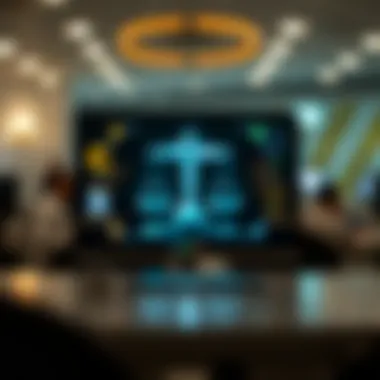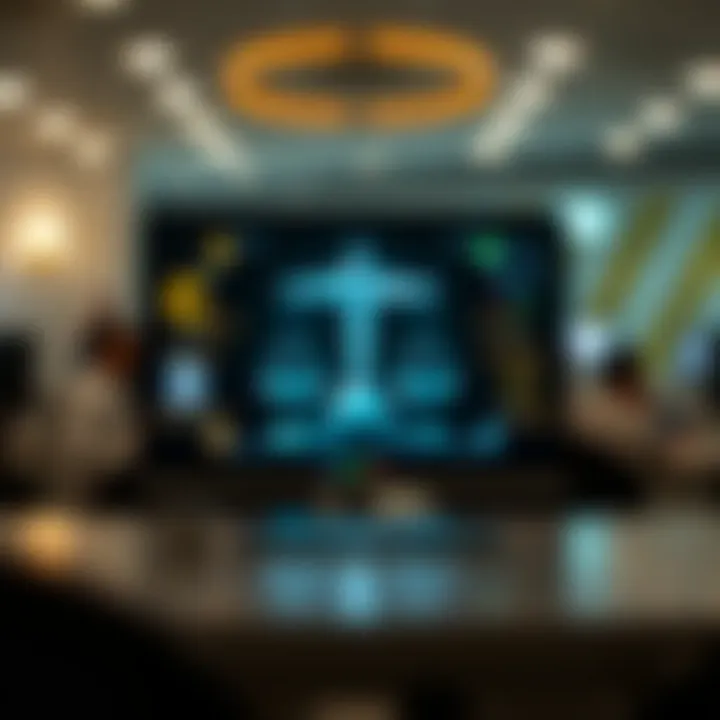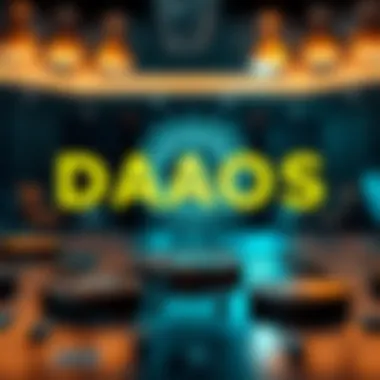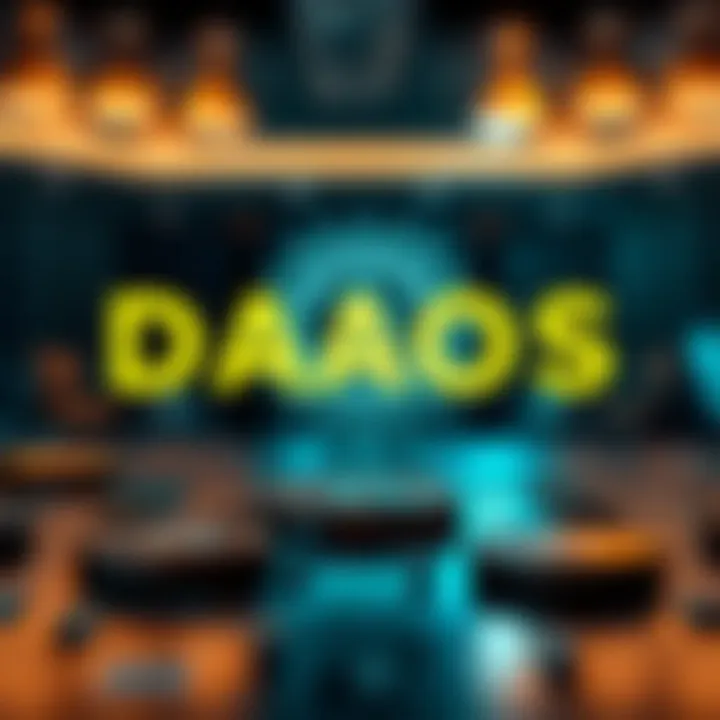Exploring DAO Cryptocurrency: Structure and Functionality


Intro
In today's rapidly evolving financial landscape, the concept of Decentralized Autonomous Organizations, or DAOs, has risen to prominence, capturing the interest of investors, tech enthusiasts, and educators alike. DAOs represent a fundamental shift in how organizations can operate within the cryptocurrency space, shifting the power dynamic from centralized institutions to community-driven models. By utilizing blockchain technology, DAOs promise increased transparency, enhanced participation, and novel governance structures.
The purpose of this article is to explore the intricacies of DAO cryptocurrency, including their foundational principles, functionality, and potential implications for the future of digital finance. Here, we unpack the central components of DAOs, ranging from their structural makeup to governance models and the challenges they face.
Cryptocurrency Basics
In order to fully appreciate the functionality of DAOs, it’s essential to grasp the foundational concepts of cryptocurrency and blockchain technology, which serve as the bedrock for these decentralized entities. Essentially, a cryptocurrency is a digital or virtual form of currency that uses cryptography for security and operates on a technology known as blockchain.
Understanding Blockchain Technology
Blockchain technology can be imagined as a digital ledger that records transactions across many computers, ensuring that the records cannot be altered retroactively without the alteration of all subsequent blocks and the consensus of the network. This structure enhances security and eliminates the need for a central authority, making it particularly suited for DAOs.
- Decentralization: Unlike traditional financial systems that rely on centralized entities like banks, blockchain is distributed across a vast network, minimizing single points of failure.
- Transparency: Every transaction is visible to all network participants, fostering trust within the community.
- Immutability: Once data is recorded, it becomes virtually impossible to change, securing the integrity of the transaction history.
Key Cryptocurrency Terms and Concepts
To navigate the DAO landscape effectively, a few key terms should be familiar:
- Smart Contracts: Self-executing contracts with the terms of the agreement directly written into code. They operate on the blockchain to automate enforcement.
- Tokens: Digital assets created on a blockchain, often representing a stake in a project or access to specific features within the ecosystem.
- Governance Tokens: Special tokens that grant holders voting rights within a DAO, allowing them to influence decision-making processes effectively.
Each of these concepts plays a pivotal role in the operational mechanics of DAOs, impacting how they function and govern themselves. The intersection of these elements creates an environment ripe for innovation, but challenges also loom, demanding careful scrutiny as DAOs venture further into mainstream finance.
DAOs not only redefine organizational structures but reimagine participation in decision-making processes, shifting control back to the individual users whom the organization serves.
In light of this, the article will navigate through specific DAO examples, explore governance models, and dissect the implications of these engaging entities in the evolving financial landscape.
Preamble to DAO Cryptocurrency
The rise of Decentralized Autonomous Organizations (DAOs) marks a pivotal chapter in the evolution of digital finance and organizational governance. As investors, tech enthusiasts, or educators endeavor to understand this innovative framework, it's crucial to grasp what a DAO entails and why its introduction into the cryptocurrency landscape holds significant implications.
At the core, DAOs represent a fusion of blockchain technology and governance. They aim to operate without central authority, allowing community-driven decision-making where every member holds a stake. This shift from traditional organizational structures not only democratizes participation but also potentially improves transparency and trust among stakeholders. In an age where data integrity is paramount, the ability for all transactions and decisions to be verifiable on a public ledger stands out.
One pivotal advantage of DAOs is their programmable nature, enabled by smart contracts. Smart contracts eliminate the need for intermediaries, reducing operational costs and streamlining processes. Imagine a charity organization where every donor can see exactly how their contributions are spent and vote on future projects. This is not just a theoretical construct; it’s actively happening in various successful DAOs today.
However, delving into DAOs also raises important considerations. Legal and regulatory challenges loom large as traditional laws often don't adequately address the decentralized nature of these entities. There’s inherently a nuanced discussion around responsibility, equity in governance, and the potential for technical vulnerabilities. These complexities underscore the importance of understanding not just how DAOs operate, but the underlying implications on a broader scale.
Key Points in This Section
- Decentralized Governance: Emphasizes community involvement in decision-making, reminiscent of participatory democracy but executed through technology.
- Transparency and Trust: The public visibility of activities within DAOs contributes to decreased opportunistic behavior, enhancing overall trust.
- Challenges to Consider: It’s essential to keep in mind the hurdles DAOs face, particularly in the legal realm.
"DAOs could be the next frontier for organizational management, bridging gaps between innovation and traditional governance models."
For those looking to dive deeper into the mechanics of DAOs, numerous resources, such as Wikipedia and discussions on platforms like Reddit, can provide additional insights.
Understanding Decentralization
Decentralization sits at the heart of the cryptocurrency revolution, showcasing how power and control can be distributed among many rather than resting in the hands of a few. This principle not only underpins the functioning of DAOs but also transforms traditional operational approaches commonly seen in corporate structures. Grasping the nuances of decentralization is essential as we explore the implications of DAOs in the crypto world.
When we talk about decentralization, it's not just a buzzword thrown around in tech circles; it's a fundamental shift in how we think about governance, economics, and even social organization. Centralized systems typically rely on a hierarchical framework where decisions flow from the top down. This arrangement often leads to inefficiencies and can stifle innovation. In contrast, decentralization democratizes power, inviting broader participation and input from all stakeholders.
The benefits of decentralization extend far beyond merely sharing power. Among them are resilience, transparency, and enhanced security. A decentralized organization can better withstand the shocks of market changes or organizational crises, as its structure isn’t vulnerable to the whims of a single decision-maker. Moreover, transparency is baked into decentralized systems—any participant can verify transactions or decisions, fostering trust in the ecosystem. And let's not forget about security; by distributing data across multiple nodes, the risks associated with a single point of failure diminish significantly.
Still, decentralization does come with its own set of challenges. It requires a cultural shift where individuals must learn to collaborate in a peer-to-peer manner, prioritizing community decision-making over traditional authority.
To sum it up, understanding decentralization is crucial if one seeks to navigate the landscape of DAOs successfully. This concept is not merely theoretical; it's a practical framework that promotes engagement, cultivates trust, and ultimately empowers a more inclusive and equitable access to governance.
Defining Decentralization
Decentralization can be defined simply as the distribution of authority, responsibility, and decision-making from a central entity to a network of individuals or groups. In the realm of cryptocurrency and DAOs, this definition extends beyond traditional governance, reflecting a radical restructuring of how entities can operate.
In a decentralized organization, decisions are made collectively by participants rather than dictated by a central authority. This participatory model enhances responsiveness to the needs of the community and fosters innovation by leveraging diverse perspectives.
- Key Characteristics of Decentralization:
- Transparency: Every transaction and decision is recorded publicly on a blockchain.
- Autonomy: Participants operate independently, with clear rules guiding their contributions and interactions.
- Resilience: The network can tolerate failures in specific nodes without collapsing.


Understanding these characteristics lays a solid groundwork for comprehending how DAOs operate and why they are poised to reshape numerous industries.
Historical Context of Decentralized Systems
To appreciate the full impact of decentralization today, a brief look back at its history is informative. The concept gained momentum with the advent of the internet, leading to a myriad of decentralized platforms and open-source software projects. Notably, initiatives such as BitTorrent revolutionized file sharing by enabling peer-to-peer connections, thus challenging the centralized service model.
The launch of Bitcoin in 2009 was a significant milestone. It marked the first successful attempt to create a decentralized currency that did not rely on banks or governments. Its underlying blockchain technology showcased how a secure and transparent ledger could function in a decentralized manner.
In the years that followed, various projects emerged, expanding the potential applications of decentralization beyond finance. The rise of social media platforms like Mastodon or Diaspora demonstrated the application of peer-to-peer networks to social interaction, allowing users to escape the confines of centralized platforms like Facebook.
Today, the exploration of decentralization continues to gain traction as society grapples with issues such as data privacy, censorship, and power imbalances. The context provided by historical examples illustrates the evolution of decentralized thought and its implications for the future of governance in digital finance.
Indeed, understanding the historical context not only informs our perspective but also allows us to foresee how decentralized models might continue to develop, particularly within the realm of cryptocurrency and DAOs.
What is a DAO?
In the rapidly transforming landscape of cryptocurrency, understanding the essence of a Decentralized Autonomous Organization (DAO) is crucial. At their core, DAOs represent a paradigm shift in how organizations can be structured and managed. They leverage blockchain technology to create an entity that operates without the need for centralized control. This notion hinges on three critical elements: autonomy, decentralization, and smart contracts. Each component plays a vital role in distinguishing DAOs from traditional organizations, providing them with unique functionalities and advantages.
Core Components of a DAO
DAOs are built on several foundational components that interact seamlessly to facilitate their operations. Key elements include:
- Smart Contracts: These executable agreements serve as the backbone of a DAO. They automate processes by encoding rules directly on the blockchain, ensuring that operations run smoothly without human intervention. Moreover, they eliminate the need for trust, since the code dictates the behavior of the organization instead of a central authority.
- Tokenization: Tokens are vital in a DAO's ecosystem. They not only represent ownership or stakes within the organization but also enable voting rights and participation in governance. Token holders can directly influence decisions, giving power back to the community.
- Decentralized Governance Framework: This framework allows participants to contribute to the decision-making process, creating an inclusive environment where all voices can be heard. Participants use their tokens for voting on proposals, ensuring that governance is truly in the hands of the community.
- Transparency Mechanisms: Blockchains are inherently transparent. Every transaction within a DAO is recorded on a public ledger, allowing all participants to verify actions and decisions. This level of visibility builds trust among participants and fosters an ethical culture.
Understanding these components offers insight into how DAOs not only function but also thrive in an environment where traditional management methods may fall short.
DAO versus Traditional Organizations
The juxtaposition between DAOs and traditional organizations is both striking and instructive. In traditional setups, you often encounter hefty hierarchies, cumbersome bureaucracy, and layers of management that can stifle innovation and slow decision-making.
In contrast, DAOs empower their members in several significant ways:
- Dynamic Governance: Unlike static boards of directors, DAOs allow for a fluid governance structure that changes based on community consensus. This adaptability can lead to faster decision-making and more responsive governance.
- Lower Overheads: Traditional organizations often incur heavy operational costs due to physical offices, management salaries, and other overheads. DAOs, on the other hand, can operate in a completely digital environment, significantly reducing costs.
- Enhanced Member Engagement: Participants in DAOs often feel a deeper connection to their organization. Every member has a say in the decision-making process, promoting accountability and a sense of belonging.
- Global Participation: One of the hallmark features of DAOs is their ability to foster collaboration across borders. Anyone with internet access can participate, breaking down geographical constraints that limit traditional organizations.
"In a DAO, governance is not just a process; it’s a shared journey that cultivates community and inclusivity."
As these organizations continue to evolve, the implications for the future of governance and community cooperation are profound. Understanding these foundational differences not only highlights the innovative potential of DAOs but also embraces the myriad of possibilities they invite into the realm of organizational management.
For further insights on the fundamentals of DAOs and how they compare to traditional structures, you may consult resources from Wikipedia or explore the discussions on platforms like Reddit.
Cryptocurrency and Smart Contracts
In the landscape of blockchain technology, cryptocurrencies and smart contracts work hand-in-hand, creating a robust, efficient system for decentralized governance and operations. The birth of cryptocurrencies like Bitcoin kickstarted a new era in financial transactions, but it's through smart contracts that decentralized protocols, particularly DAOs (Decentralized Autonomous Organizations), achieve their full potential. Understanding this relationship is essential; it sheds light on not just how DAOs function, but also the key benefits they offer over traditional governance structures.
Role of Smart Contracts in DAOs
Smart contracts are essentially self-executing contracts with the terms of the agreement directly written into code. In the realm of DAOs, they serve a pivotal role. These contracts automate decision-making processes, reduce the risk of manipulation, and eliminate the need for intermediaries. For instance, in a DAO, smart contracts can automate voting processes. When a member casts a vote, the contract evaluates the outcome automatically without any human intervention. This ensures that the operation is not only efficient but also transparent—a key selling point for DAOs.
The adoption of smart contracts comes with several notable advantages:
- Transparency: Since the code is publicly accessible, all participants can verify the terms and outcomes at any time.
- Immutability: Once deployed, smart contracts cannot be altered, meaning the rules are set in stone and cannot be changed without consensus.
- Trust: With no central authority to influence decisions, trust lies in the code rather than individuals.
However, reliance on smart contracts does not come without challenges. Bugs or vulnerabilities in the contract's code can lead to unexpected consequences. An infamous instance was the 2016 DAO hack, where vulnerabilities in the smart contract led to the exploitation of millions in Ether. Such instances underscore the importance of rigorous auditing before deployment.
Programming and Automation in DAOs
Programming forms the backbone of DAOs, giving life to smart contracts through various coding languages like Solidity for Ethereum-based projects. This programming layer allows developers to create specific functions that respond to user interactions, such as proposals and voting mechanisms. As a result, DAOs can automate many routine operations that would otherwise require human oversight.
One could think of programming in DAOs as akin to the conductor of an orchestra. Just as the conductor guides the musicians to perform harmoniously, programming orchestrates various functions and interactions, ensuring that every part of the organization operates smoothly.
Several key programming aspects facilitate this automation:
- Automation of Routine Tasks: Routine functions such as fund distribution, proposal reviews, and membership validations can be handled automatically. This minimization of manual intervention reduces errors and increases operational efficiency.
- Dynamic Responses: DAOs can be programmed to respond dynamically to certain conditions or voting outcomes. For example, if a proposal passes, tokens may be automatically redistributed to the community.
- Customization of Processes: DAOs can craft unique governance structures suited to their needs, allowing for varied levels of participation and consensus mechanisms.
Automation comes with its own set of benefits and drawbacks. While it streamlines processes, the rigidity of automated systems can hinder flexibility. Changes can often necessitate lengthy discussions and coding work, impeding swift adaptation to new challenges or opportunities.
Governance Models of DAOs


Governance models form the backbone of Decentralized Autonomous Organizations (DAOs). They define how decisions are made, how power is distributed, and how the community interacts and collaborates. Unlike traditional organizations where a handful of individuals hold the reins, DAOs seek to distribute authority among all members. This not only encourages active participation but also fosters greater investment in the organization's success. Understanding the governance dynamics of DAOs provides a clearer view of their potential as disruptors in the financial ecosystem.
Voting Mechanisms
Voting mechanisms are central to how decisions are made in a DAO. Here, every member typically has a say based on their holdings and contributions, which can influence decision outcomes significantly. Different DAOs employ varied voting methodologies. For instance, some operate on a simple majority rule, while others might lean towards a quorum system, ensuring that a minimum number of members are present for a vote to carry weight. A few DAOs even explore Quadratic Voting, where the power of a vote increases with the intensity of preference, potentially leveling the playing field among participants with different stakes.
Through these mechanisms, DAOs can tackle pivotal issues such as fund allocations, protocol changes, or community initiatives, ensuring that voices from a diverse range of members resonate in the decision-making process.
"In a DAO, governance isn’t dictated from the top; it’s a ripple effect of community interaction and collective choice."
Token-Based Governance
Token-based governance is another prominent model within DAOs. Essentially, governance tokens are issued to members, often based on their investment or participation within the organization. The more tokens one holds, the greater their voting power. This mechanism aligns the interests of token holders with the long-term success of the DAO. However, it also introduces a challenge: large holders can potentially dominate decision-making, thereby marginalizing smaller stakeholders. This concern has prompted some DAOs to implement voting caps or other mechanisms to mitigate the impact of whale voting.
This approach encourages participants to engage not only as voters but also as active contributors to the ecosystem, further promoting responsibility and accountability.
Inclusivity and Participation
Inclusivity and participation are critical elements in the governance model of any DAO. Unlike traditional setups where access and influence can be limited to a select few, DAOs strive to democratize participation. Ethereryone, regardless of background or financial investment, should have a chance to participate in the decision-making.
To enhance participation, many DAOs utilize innovative strategies to engage their communities. Educational initiatives can bridge knowledge gaps, while ongoing discussions on platforms like Reddit or Discord facilitate open dialogue about proposals and their implications. In addition, inclusive governance can involve strategies like delegation, where members can empower others to vote on their behalf, thus not only broadening participation but also ensuring that voices that might otherwise be subdued have a platform.
In summary, the governance models of DAOs represent a paradigm shift in organizational management, prioritizing collective input and diverse perspectives. Emphasizing transparency, participation, and equitable power distribution makes DAOs a fascinating case study in the intersection of technology and governance.
Potential Benefits of DAOs
In the complex landscape of decentralized finance, Decentralized Autonomous Organizations (DAOs) offer a fresh perspective on how entities can operate. Their range of potential benefits makes them a subject of keen interest for a variety of stakeholders including investors, tech enthusiasts, and educators. Understanding these advantages is key to grasping the transformative power of DAOs in today’s digital economy.
Enhanced Transparency and Trust
One of the standout features of DAOs is their commitment to transparency. In traditional organizations, decision-making processes often happen behind closed doors, leading to potential suspicion and distrust among stakeholders. In contrast, DAOs utilize blockchain technology that records every action taken on the network in an immutable ledger.
"The transparency provided by blockchain can foster a culture of accountability and trust, which is valuable for building long-term relationships among members."
This clarity allows all participants to verify transactions and decisions in real time, significantly reducing the likelihood of corruption or misconduct. Furthermore, the community-driven governance structures pave the way for members to actively participate in shaping important decisions. This inclusion enhances trust levels among members, as everyone can see how their contributions influence outcomes.
Reduced Operational Costs
Operational efficiency is another major selling point for DAOs. Traditional businesses incur a multitude of costs tied to administrative functions, human resources, and overheads. DAOs, however, are designed to minimize these expenses through smart contracts, which automate tasks that might otherwise require human intervention.
For example, tasks such as fund disbursement and voting procedures can be programmed to occur automatically once certain conditions are met. This not only saves on labor costs but also significantly speeds up processes. Many DAOs report lower management costs when compared to brick-and-mortar organizations because they leverage technology to streamline operations. As a result, resources can be allocated more effectively, enhancing overall performance.
Global Collaboration
The internet has already made the world a smaller place, but DAOs take global collaboration to unprecedented heights. With conventional organizations, geographical barriers can hinder participation and collaboration. However, DAOs are inherently borderless, allowing individuals from different backgrounds and locales to unite for a common cause.
In these organizations, anyone with internet access can contribute, provided they have the requisite tokens or permissions, democratizing participation in governance. For example, Gitcoin, a DAO focused on supporting open-source projects, allows developers from all over the world to collaborate, share expertise, and fund innovative solutions without geographical limitations. This pooling of diverse talent can lead to more innovative solutions, as members bring varied perspectives and skill sets into the mix.
In summary, the potential benefits of DAOs—enhanced transparency and trust, reduced operational costs, and opportunities for global collaboration—position them as critical entities in the future of organizational frameworks. Understanding these advantages enables stakeholders to appreciate the impact DAOs can have on reshaping how we think about governance and decision-making in the digital age.
For more in-depth analysis on DAOs, you might find useful resources like the Wikipedia page on DAOs insightful.
Challenges Facing DAOs
As the realm of cryptocurrency expands, Decentralized Autonomous Organizations (DAOs) confront an array of challenges that could impede their progress and functionality. These obstacles are pivotal to understanding the pragmatic implications of DAOs, as they intertwine with legal frameworks, security needs, and growth scalability. Addressing these challenges is not merely about overcoming hurdles; it involves a keen awareness of the broader context in which DAOs operate and how they can flourish despite these hurdles.
Legal and Regulatory Hurdles
Navigating the legal landscape is daunting for many DAOs. These organizations exist in a gray area of law, stretching across various jurisdictions with conflicting regulations. While traditional corporations have clear legal structures, DAOs often operate without explicit recognition in the eyes of lawmakers. This absence creates uncertainty around liability, intellectual property rights, and taxation. Moreover, regulatory bodies like the U.S. Securities and Exchange Commission remain cautious, raising concerns over whether tokens issued by DAOs should be classified as securities.
To illustrate, consider how regulatory approaches differ globally. In Europe, certain jurisdictions offer more favorable conditions for tokenized economies, while others enforce stringent regulations. This patchwork of laws can stifle innovation and deter participation from potential members. Therefore, understanding and engaging with legal frameworks is crucial for DAOs to thrive.
Security Vulnerabilities
The technical backbone of DAOs—including smart contracts—is at heightened risk of vulnerabilities. History has shown that small coding errors or oversight can lead to catastrophic failures, resulting in significant financial losses. One of the most notable incidents was the DAO hack in 2016, where attackers exploited a vulnerability to drain millions in Ether. This underscores that even well-structured organizations can tumble if their security protocols are lax.
To safeguard against these threats, it’s imperative for DAOs to conduct thorough audits, implement rigorous testing processes, and establish robust security measures. Furthermore, security is not a one-time assessment but rather a continuous practice requiring regular updates and responsive protocols to deal with emerging threats. A proactive security strategy may not eliminate risks entirely but can significantly mitigate potential damages.


Scalability Issues
As DAOs grow, scalability often presents a daunting challenge. A DAO that works efficiently with a small number of members may not perform similarly once its community expands. The mechanisms that govern decision-making and the processing of transactions can become bottlenecks, leading to delays and inefficiencies.
Some DAOs may adopt a model of tiered governance, where smaller groups manage various aspects of the organization. This approach can help manage increased activity but also introduces complexity. Furthermore, issues arise in maintaining member engagement and ensuring fair representation while scaling operations.
Moreover, as transaction volume increases, network congestion can lead to higher fees and longer processing times, creating frustration among members. For DAOs to enhance their scalability, they need to anticipate growth and adapt their technological frameworks and governance models accordingly. Several DAOs implement off-chain solutions or layer-2 protocols to address scalability, but these measures must be effectively aligned with their decentralized ethos.
In summary, while DAOs hold immense promise, they grapple with critical challenges that require thoughtful strategies and proactive engagement. Facing these hurdles head-on will not only pave the way for sustainable growth but also enhance their legitimacy in a rapidly evolving financial landscape.
"Navigating the intricate dance of legal, security, and scalability issues is crucial for the success of DAOs in the cryptocurrency space."
For those exploring deeper insights into DAOs and their complexities, resources like Wikipedia and Britannica can provide extensive knowledge. Additionally, joining discussions on platforms such as Reddit can help enthusiasts and investors stay updated on ongoing developments.
Case Studies of Successful DAOs
Exploring successful Decentralized Autonomous Organizations (DAOs) offers valuable insights into how they operate and thrive in today’s digital landscape. Case studies provide concrete examples of the principles discussed earlier in the article, turning abstract concepts into tangible realities. By analyzing these examples, one pinpoints the distinct advantages DAOs can offer, alongside pitfalls they’ve encountered. This examination serves not just to educate but also to inspire potential investors, tech enthusiasts, and educators about the practical implications of DAOs.
MakerDAO
MakerDAO stands as a cornerstone in the DAO ecosystem, showcasing how decentralized entities can manage complex financial systems independently of traditional banking structures. Founded in 2014, it has built a system that allows users to generate DAI, a stablecoin pegged to the US dollar, via over-collateralized loans. Users deposit cryptocurrencies as collateral—typically Ethereum—and then can borrow DAI against this collateral, promoting a secured yet flexible financial framework.
One notable element of MakerDAO is its multi-collateral DAI feature, which enables various cryptocurrencies to be used as collateral. This adaptability promotes a sense of inclusivity within the community, as different user needs can be catered for. Furthermore, the use of smart contracts automates liquidation processes, adding layers of transparency and trust with almost no human intervention.
However, it hasn't been a smooth ride. MakerDAO has faced considerable challenges, particularly during market fluctuations when collateral values plummeted. Such events raise critical discussions on security vulnerabilities and risk management. When the crypto market tumbled in March 2020, MakerDAO experienced significant volatility, leading to the liquidations of many positions, which sparked debates about governance and the stability of the DAI peg.
“MakerDAO represents a case where decentralization and innovative financial instruments converge; however, it also highlights the challenges in maintaining stability.”
Aave Protocol
Another noteworthy example is the Aave Protocol, which emerged in 2020 as a distinctive lending platform. The underlying concept behind Aave revolves around allowing users to lend and borrow assets in a trustless environment. Aave employs innovative features like flash loans, enabling users to borrow liquidity without collateral, provided the loan is paid back within the same transaction.
Aave's governance is driven by its AAVE token, giving holders the right to vote on protocol upgrades and decision-making processes. This token-based governance mechanism aligns the interests of stakeholders and encourages active community engagement. What sets Aave apart further is its emphasis on security audits, making substantial efforts to ensure that their smart contracts are robust and minimize risks for users.
Despite this, Aave isn’t without its bumps. In recent months, there have been discussions around the need for clearer regulatory frameworks that govern decentralized financial products like Aave. Such considerations could be crucial for the platform’s future growth and scalability.
The Future of DAOs in Cryptocurrency
The landscape of cryptocurrency is continuously evolving, and as we look to the future, Decentralized Autonomous Organizations (DAOs) sit at the forefront of this progression. DAOs encapsulate innovation, allowing for a governance model that promotes community involvement and transparent decision-making. Understanding the future of DAOs involves recognizing their growing significance in various sectors, including finance, governance, and beyond.
DAOs promise an environment where every voice matters. As technology improves, the capability of these organizations to handle more complex projects increases. This potential is intriguing, as it hints at a future where decision-making is not merely relegated to a few individuals but instead shared across diverse groups. The implications of this shift resonate throughout the realms of investment, entrepreneurship, and democracy.
Emerging Trends
As we gaze into the horizon of DAOs, several emerging trends catch the eye:
- Cross-Chain Interoperability
DAOs are looking to expand their functionality beyond isolated blockchain networks. By enabling cross-chain operations, DAOs will encourage greater collaboration and resource sharing among various projects, disrupting existing silos in the blockchain ecosystem. - Integration of AI and Machine Learning
The infusion of artificial intelligence into DAOs can result in algorithms that adapt and learn from real-time data. This adaptability could streamline operations, enhance decision-making processes, and improve user participation. - Increasing Regulatory Clarity
As governments and regulatory bodies become more aware of cryptocurrency’s role in the economy, clearer regulations will likely emerge. DAOs, equipped with transparent protocols, could align more easily with these regulations, fostering legitimacy and encouraging traditional institutions to participate. - Focus on Social Impact Initiatives
Many new DAOs are focusing on social causes, prioritizing sustainability and community welfare alongside profit. Such movements could democratize funding for local projects, thus becoming catalysts for positive change in various communities.
Considering these trends, it is vital for stakeholders to keep their fingers on the pulse of DAOs to seize opportunities as they arise. The trend of taking control away from centralized structures and placing it in the hands of community members may very well redefine our approach to organizational governance.
Institutional Adoption Perspectives
The potential of DAOs is not lost on institutional investors and large organizations. Their involvement in this decentralized paradigm signifies a profound change in how business can operate.
- Reducing Operational Risks
Institutional players recognize that DAOs can streamline operations, cut down administrative layers, and ultimately mitigate operational risks, leading to a more agile organizational structure. - Attracting New Capital
DAOs can create attractive investment opportunities. They offer a unique value proposition through tokenomics and community-driven initiatives, which can draw the interest of traditional investors looking for innovative ventures. - Building Trust Through Transparency
In a world where trust in systems is dwindling, DAOs stand out by offering transparency in operations and decision-making. This transparency could potentially build stronger relationships between consumers and companies.
As we observe shifts in institutional attitudes, it's evident that DAOs are evolving from niche experiments to potential mainstream solutions. The close of one chapter marks the beginning of another, one where DAOs may redefine how organizations collaboratively operate and thrive.
"In the realm of decentralized governance, empowerment is just as crucial as innovation; it’s the bridge that connects technology with community needs."
smartcontract.com offers some intriguing insights into how DAOs can further this journey. It's imperative that as investors, tech enthusiasts, and educators, we remain vigilant, informed, and adaptable to these shifts as they might reshape the future of finance and organizations._
Closure
The conclusion of this article serves as more than just a summary; it encapsulates the profound implications of Decentralized Autonomous Organizations (DAOs) in the cryptocurrency landscape. The exploration of DAOs unveils a world where traditional governance structures are challenged, pushing the boundaries of how organizations can function and interact.
In essence, DAOs have a potential not just as a technical advancement but as a philosophical shift in organizational thinking. By decentralizing governance, they empower individuals to have a stake in decisions rather than relegating authority to a select few. This movement fosters
- Increased participation: Individuals from varied backgrounds can play a role in decision making, leading to a richer tapestry of ideas and innovations.
- Enhanced transparency: The utilization of blockchain technology ensures that operations are documented and publicly available, thus fostering trust among participants.
- Innovative financial opportunities: DAOs can create new models of fund allocation and revenue sharing, enabling a more equitable distribution of wealth.
Nevertheless, it’s crucial to consider that the journey of DAOs is not navigated without turbulence. Regulatory challenges and security vulnerabilities remain pressing issues. How these organizations address such hurdles will significantly shape their evolution and acceptance within the broader financial ecosystem.
As we look to the future, the position of DAOs as a transformative force within cryptocurrency is increasingly likely. The institutional interest in DAOs may accelerate their emergence as a dominant organizational model in digital finance. As investors, tech enthusiasts, and educators delve deeper into this realm, understanding the nuances involved in the structure and functionality of DAOs becomes paramount.
The relationship between DAOs and traditional financial systems will likely continue to evolve, prompting a reconsideration of established norms around governance and authority. Therefore, recognizing the complexity of DAOs is vital, as it equips us with the knowledge to navigate and adapt to an ever-changing digital finance landscape. This journey promises not only to redefine the rules of engagement but also to enhance personal and community empowerment in an age increasingly dominated by technology.







